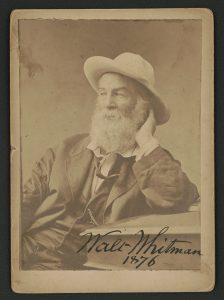Liquid Whitman Gains a Locomotive and a Captain
 Since my Liquid Whitman post in July, more 12-ounce tributes to the poet’s Bicentennial have emerged in the Leaves of Grass Series from Bell’s Brewery. I’ve reviewed three of them for The Massachusetts Review, situating each within the contexts of the namesake poem, Whitman’s career, and beer culture. Part of my process in writing these reviews is conversations with friends. We read the poems aloud together, sharing our spontaneous reactions as well as our individual vocal inflections. We drink in Whitman’s poems, relishing their nineteenth-century diction and American exuberance, their geographic and demographic reach, their bouts of boisterousness and beauty. We take a break from our routines and talk about things we usually don’t. My pop-up poetry salons operate outside the classroom and the coffee house.
Since my Liquid Whitman post in July, more 12-ounce tributes to the poet’s Bicentennial have emerged in the Leaves of Grass Series from Bell’s Brewery. I’ve reviewed three of them for The Massachusetts Review, situating each within the contexts of the namesake poem, Whitman’s career, and beer culture. Part of my process in writing these reviews is conversations with friends. We read the poems aloud together, sharing our spontaneous reactions as well as our individual vocal inflections. We drink in Whitman’s poems, relishing their nineteenth-century diction and American exuberance, their geographic and demographic reach, their bouts of boisterousness and beauty. We take a break from our routines and talk about things we usually don’t. My pop-up poetry salons operate outside the classroom and the coffee house.
You won’t learn much about me in these reviews. But you’ll likely  discern that I like describing taste sensations and I enjoy teaching poetry. I hope you will consider reading the poems aloud in good company and talking them over, just for fun. Here are the introductions to my recent reviews of To a Locomotive in Winter (a smoked porter) and O Captain! My Captain! (a black lager). Click on the titles to read more. –MB
discern that I like describing taste sensations and I enjoy teaching poetry. I hope you will consider reading the poems aloud in good company and talking them over, just for fun. Here are the introductions to my recent reviews of To a Locomotive in Winter (a smoked porter) and O Captain! My Captain! (a black lager). Click on the titles to read more. –MB
Brew the Locomotion for Whitman’s Marvelous Machine
Most great American train songs are really about people. But Walt Whitman’s “To a Locomotive in Winter” and Emily Dickinson’s “I like to see it lap the miles” are machinist at heart. They don’t depict engineers, stokers, and passengers. They don’t take you home, and they won’t bring your baby back. Dickinson’s mechanical animal, a frolicsome iron horse, rounds mountains and crosses valleys before finally coming to a stop. But Whitman’s train keeps on coming, making a constant locomotion: throbbing, gyrating, shuttling, protruding, careering, rumbling, rousing. Two decades before the Lumière Brothers’ train arrived at its celluloid station, Whitman’s marvelous machine rocketed into the sky—anticipating the pipe-bridled locomotives in F. T. Marinetti’s Futurist manifesto. The poem’s newest incarnation is a smoked porter, the fourth offering in Bell’s ongoing Leaves of Grass Series celebrating Whitman’s bicentennial. . . .
Bells for Whitman’s Captain
What’s an elegy for Abraham Lincoln doing in a 12-ounce beer bottle? The third Walt Whitman tribute in Bell’s Leaves of Grass Series reinvents the poet’s preferred beer style as a confluence of American Black Ale and India Pale Lager. Bringing roasty malts and Michigan hops to lager’s crispness, Bell’s Brewery labels O Captain! My Captain! a Black India-Style Pale Lager. Even with this mouthful of attributes, its mouthfeel is light. This beer isn’t as dark and opaque as a stout, but the head is frothier—with bead-sized bubbles floating amidst the tiny ones. It rises up in your glass like sea foam.
So why Whitman’s Captain for this enhanced lager? The poem’s publishing history links to its “India-Style.” First appearing in a newspaper in 1865, “O Captain! My Captain!” migrated to Passage to India (1871) before ending up in the 1881 Leaves of Grass. Certainly lager’s longstanding popularity pairs well with the most recited Whitman poem during his lifetime. . . .
SOURCES
Locomotive GIF, https://www.ushistory.org/us/25b.asp
1876 Photograph of Walt Whitman, Library of Congress, www.loc.gov/item/2018662291/
Comments are currently closed.